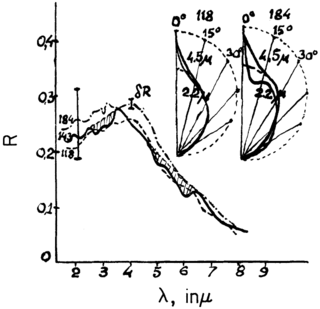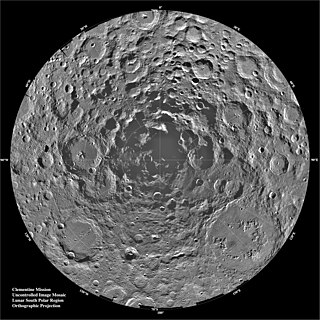Related Research Articles

The Moon is Earth's only natural satellite. At about one-quarter the diameter of Earth, it is the largest natural satellite in the Solar System relative to the size of its planet, the fifth largest satellite in the Solar System overall, and is larger than any known dwarf planet. Orbiting Earth at an average distance of 384,400 km (238,900 mi), or about 30 times Earth's diameter, its gravitational influence slightly lengthens Earth's day and is the main driver of Earth's tides. The Moon is classified as a planetary-mass object and a differentiated rocky body, and lacks any significant atmosphere, hydrosphere, or magnetic field. Its surface gravity is about one-sixth of Earth's ; Jupiter's moon Io is the only satellite in the Solar System known to have a higher surface gravity and density.

A lander is a spacecraft that descends towards, and comes to rest on, the surface of an astronomical body. In contrast to an impact probe, which makes a hard landing that damages or destroys the probe upon reaching the surface, a lander makes a soft landing after which the probe remains functional.

Project A119, also known as A Study of Lunar Research Flights, was a top-secret plan developed in 1958 by the United States Air Force. The aim of the project was to detonate a nuclear bomb on the Moon, which would help in answering some of the mysteries in planetary astronomy and astrogeology. If the explosive device detonated on the surface, and not in a lunar crater, the flash of explosive light would have been faintly visible to people on Earth with their naked eye. This was meant as a show of force resulting in a possible boosting of domestic morale in the capabilities of the United States, a boost that was needed after the Soviet Union took an early lead in the Space Race and was also working on a similar project.
The Lunar Precursor Robotic Program (LPRP) is a program of robotic spacecraft missions which NASA has used to prepare for future human spaceflight missions to the Moon by 2010. Two LPRP missions, the Lunar Reconnaissance Orbiter (LRO) and the Lunar Crater Observation and Sensing Satellite (LCROSS), were launched in June 2009. The lift off above Cape Canaveral Air Force Station in Florida was successful on June 18, 2009. The unmanned Atlas V rocket launched the two space probes towards the Moon, where they will provide a 3-D map and search for water in conjunction with the Hubble Space Telescope.

Colonization of the Moon is a concept employed by some proposals of establishing permanent human settlement or robotic presence on the Moon, the closest astronomical body to Earth, and the Earth's only natural satellite.

Shackleton is an impact crater that lies at the south pole of the Moon. The peaks along the crater's rim are exposed to almost continual sunlight, while the interior is perpetually in shadow. The low-temperature interior of this crater functions as a cold trap that may capture and freeze volatiles shed during comet impacts on the Moon. Measurements by the Lunar Prospector spacecraft showed higher than normal amounts of hydrogen within the crater, which may indicate the presence of water ice. The crater is named after Antarctic explorer Ernest Shackleton.

Chandrayaan-1 was the first Indian lunar probe under the Chandrayaan program. It was launched by the Indian Space Research Organisation in October 2008, and operated until August 2009. The mission included a lunar orbiter and an impactor. India launched the spacecraft using a PSLV-XL rocket on 22 October 2008 at 00:52 UTC from Satish Dhawan Space Centre, at Sriharikota, Andhra Pradesh. The mission was a major boost to India's space program, as India researched and developed its own technology in order to explore the Moon. The vehicle was inserted into lunar orbit on 8 November 2008.

Cabeus is a lunar impact crater that is located about 100 km (62 mi) from the south pole of the Moon. At this location the crater is seen obliquely from Earth, and it is almost perpetually in deep shadow due to lack of sunlight. Hence, not much detail can be seen of this crater, even from orbit. Through a telescope, this crater appears near the southern limb of the Moon, to the west of the crater Malapert and to the south-southwest of Newton.

A Moon landing is the arrival of a spacecraft on the surface of the Moon. This includes both crewed and robotic missions. The first human-made object to touch the Moon was the Soviet Union's Luna 2, on 13 September 1959.

Lunar water is water that is present on the Moon. It was first discovered by NASA's Apollo 14 mission in 1971. Diffuse water molecules can persist at the Moon's sunlit surface, as discovered by NASA's SOFIA observatory in 2020. Gradually water vapor is decomposed by sunlight, leaving hydrogen and oxygen lost to outer space. Scientists have found water ice in the cold, permanently shadowed craters at the Moon's poles. Water molecules are also in the extremely thin lunar atmosphere.

The Lunar Crater Observation and Sensing Satellite (LCROSS) was a robotic spacecraft operated by NASA. The mission was conceived as a low-cost means of determining the nature of hydrogen detected at the polar regions of the Moon. Launched immediately after discovery of lunar water by Chandrayaan-1, the main LCROSS mission objective was to further explore the presence of water in the form of ice in a permanently shadowed crater near a lunar polar region. It was successful in confirming water in the southern lunar crater Cabeus.
A cold trap is a concept in Planetary Sciences that describes an area cold enough to freeze (trap) volatiles. Cold-traps can exist on the surfaces of airless bodies or in the upper layers of an adiabatic atmosphere. On airless bodies, the ices trapped inside cold-traps can potentially remain there for geologic time periods, allowing us a glimpse into the primordial solar system. In adiabatic atmospheres, cold-traps prevent volatiles from escaping the atmosphere into space.

The Lunar Reconnaissance Orbiter (LRO) is a NASA robotic spacecraft currently orbiting the Moon in an eccentric polar mapping orbit. Data collected by LRO have been described as essential for planning NASA's future human and robotic missions to the Moon. Its detailed mapping program is identifying safe landing sites, locating potential resources on the Moon, characterizing the radiation environment, and demonstrating new technologies.

The Moon Impact Probe (MIP) developed by the Indian Space Research Organisation (ISRO), India's national space agency, was a lunar probe that was released by ISRO's Chandrayaan-1 lunar remote sensing orbiter which in turn was launched, on 22 October 2008, aboard a modified version of ISRO's Polar Satellite Launch Vehicle. It discovered the presence of water on the Moon.

The lunar south pole is of special interest to scientists because of the occurrence of water ice in permanently shadowed areas around it. The lunar south pole region features craters that are unique in that the near-constant sunlight does not reach their interior. Such craters are cold traps that contain a fossil record of hydrogen, water ice, and other volatiles dating from the early Solar System. In contrast, the lunar north pole region exhibits a much lower quantity of similarly sheltered craters.
Peter H. Schultz is Professor of Geological Sciences at Brown University specializing in the study of planetary geology, impact cratering on the Earth and other objects in the Solar System, and volcanic modifications of planetary surfaces. He was co-investigator to the NASA Science Mission Directorate spacecraft Deep Impact and the Lunar Crater Observation and Sensing Satellite (LCROSS). He was awarded the Barringer Medal of the Meteoritical Society in 2004 for his theoretical and experimental studies of impact craters.

A permanently shadowed crater is a depression on a body in the Solar System within which lies a point that is always in darkness.
The following outline is provided as an overview of and topical guide to the Moon:

VIPER is a lunar rover developed by NASA, and currently planned to be delivered to the surface of the Moon in November 2023. The rover will be tasked with prospecting for lunar resources in permanently shadowed areas in the lunar south pole region, especially by mapping the distribution and concentration of water ice. The mission builds on a previous NASA rover concept called Resource Prospector, which was cancelled in 2018.
References
- ↑ Sharp, Tim (27 October 2017). "What is the Temperature on the Moon?". Space.com. Retrieved 25 November 2017.
- ↑ "Diviner Observes LCROSS Impact". University of California, Los Angeles. 9 October 2009. Retrieved 9 June 2016.